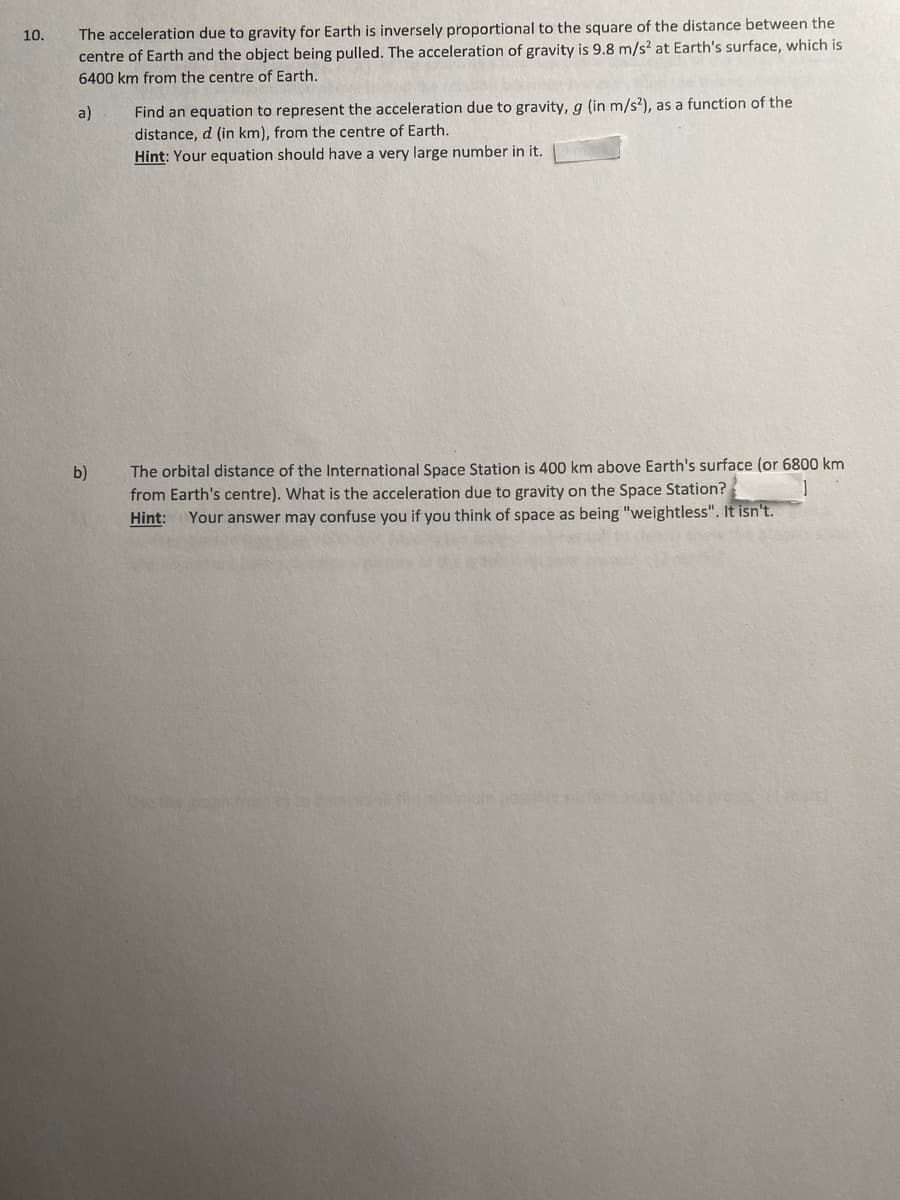The acceleration due to gravity for Earth is inversely proportional to the square of the distance between the centre of Earth and the object being pulled. The acceleration of gravity is 9.8 m/s² at Earth's surface, which is 10. 6400 km from the centre of Earth. Find an equation to represent the acceleration due to gravity, g (in m/s?), as a function of the distance, d (in km), from the centre of Earth. Hint: Your equation should have a very large number in it. a) The orbital distance of the International Space Station is 400 km above Earth's surface (or 6800 km from Earth's centre). What is the acceleration due to gravity on the Space Station? b) Hint: Your answer may confuse you if you think of space as being "weightless". It isn't.
The acceleration due to gravity for Earth is inversely proportional to the square of the distance between the centre of Earth and the object being pulled. The acceleration of gravity is 9.8 m/s² at Earth's surface, which is 10. 6400 km from the centre of Earth. Find an equation to represent the acceleration due to gravity, g (in m/s?), as a function of the distance, d (in km), from the centre of Earth. Hint: Your equation should have a very large number in it. a) The orbital distance of the International Space Station is 400 km above Earth's surface (or 6800 km from Earth's centre). What is the acceleration due to gravity on the Space Station? b) Hint: Your answer may confuse you if you think of space as being "weightless". It isn't.
University Physics Volume 1
18th Edition
ISBN:9781938168277
Author:William Moebs, Samuel J. Ling, Jeff Sanny
Publisher:William Moebs, Samuel J. Ling, Jeff Sanny
Chapter1: Units And Measurement
Section: Chapter Questions
Problem 14P: The Scope and Scale of Physics Find the order of magnitude of the following physical quantities. (a)...
Related questions
Question
100%

Transcribed Image Text:The acceleration due to gravity for Earth is inversely proportional to the square of the distance between the
centre of Earth and the object being pulled. The acceleration of gravity is 9.8 m/s? at Earth's surface, which is
10.
6400 km from the centre of Earth.
Find an equation to represent the acceleration due to gravity, g (in m/s?), as a function of the
distance, d (in km), from the centre of Earth.
a)
Hint: Your equation should have a very large number in it.
The orbital distance of the International Space Station is 400 km above Earth's surface (or 6800 km
from Earth's centre). What is the acceleration due to gravity on the Space Station?
b)
Hint:
Your answer may confuse you if you think of space as being "weightless". It isn't.
De the
Expert Solution
This question has been solved!
Explore an expertly crafted, step-by-step solution for a thorough understanding of key concepts.
Step by step
Solved in 2 steps with 2 images

Knowledge Booster
Learn more about
Need a deep-dive on the concept behind this application? Look no further. Learn more about this topic, physics and related others by exploring similar questions and additional content below.Recommended textbooks for you

University Physics Volume 1
Physics
ISBN:
9781938168277
Author:
William Moebs, Samuel J. Ling, Jeff Sanny
Publisher:
OpenStax - Rice University

College Physics
Physics
ISBN:
9781305952300
Author:
Raymond A. Serway, Chris Vuille
Publisher:
Cengage Learning

Principles of Physics: A Calculus-Based Text
Physics
ISBN:
9781133104261
Author:
Raymond A. Serway, John W. Jewett
Publisher:
Cengage Learning

University Physics Volume 1
Physics
ISBN:
9781938168277
Author:
William Moebs, Samuel J. Ling, Jeff Sanny
Publisher:
OpenStax - Rice University

College Physics
Physics
ISBN:
9781305952300
Author:
Raymond A. Serway, Chris Vuille
Publisher:
Cengage Learning

Principles of Physics: A Calculus-Based Text
Physics
ISBN:
9781133104261
Author:
Raymond A. Serway, John W. Jewett
Publisher:
Cengage Learning

An Introduction to Physical Science
Physics
ISBN:
9781305079137
Author:
James Shipman, Jerry D. Wilson, Charles A. Higgins, Omar Torres
Publisher:
Cengage Learning

Physics for Scientists and Engineers: Foundations…
Physics
ISBN:
9781133939146
Author:
Katz, Debora M.
Publisher:
Cengage Learning

Glencoe Physics: Principles and Problems, Student…
Physics
ISBN:
9780078807213
Author:
Paul W. Zitzewitz
Publisher:
Glencoe/McGraw-Hill